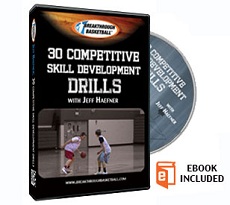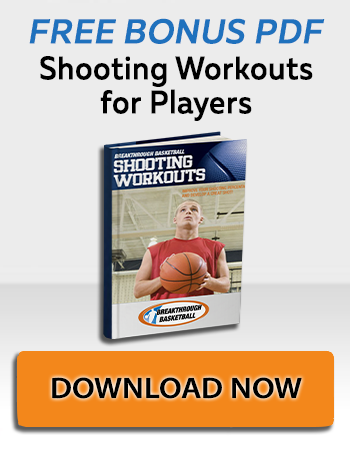Basic Lay-ups
Lay-ups are the backbone of any team offense and every player's offensive repertoire. Without the threat of a lay-up, all other shots would become next to impossible. Just think, how you would defend if you knew that lay-ups were not allowed? What offense, what screens would be set, what dribble or one – on – one move would you make if you could not take a lay-up?
Interesting food for thought. Yet the lay-up is the shot we spend the least time on and the most technically ignored shot of all.
How do we make lay-ups?
I ask you, what part of the body allows you to make lay-ups? Your hand? Your arms? Your legs?
I think you make lay-ups with your eyes. With all that goes on around you during a basketball game, that activity level increases ten-fold as you get closer to the basket. There are more players, more defenders, more hands, and more contact the closer you get to the basket. The demand for your concentration goes up accordingly. No matter what else you do, you must keep your eyes on the prize. Block out all that is going on around you, and keep your eyes on the target until the ball comes through the net.
What is a lay-up
A lay-up is just what it sounds like: a shot where we lay the ball up on the backboard or over the rim and into the basket. It can be done forwards, backwards, or sideways. It is a lay-up just the same.
Teaching lay-ups
I am a big believer in visualization and pantomime when teaching new skills. They are especially effective techniques when teaching lay-ups.
When teaching new concepts of leg drive and follow-through while handling a basketball and trying to throw it through the basket, consider that it might be very difficult for young players to keep track of all the factors involved. You would be well advised to simplify the process by eliminating the ball at first.
Try these techniques without a ball.
- Line up your team in rows.
- On the command, ”Set”, have them stand with their left leg forward and their right leg extended straight back. Knees should be bent and hips low in an athletic posture.
- On the command, “Drive,” have them step forward with their right leg, without taking their left foot off the floor, and drive their right knee in the air. The visualization phrase that I use is "Try to hit your nose with your knee."
- After driving the right knee, talk a little about the feeling they get when they drive the knee. They should feel their whole body lifting.
- Next, on the command “Drive,” combine the knee lift with a jump off the left leg. It might take a few reps to co-ordinate the knee drive with the jump but it will come quickly.
- Next, give the command "Drive," and, at the appropriate time, add the command, "Shoot." Players then go into a right- handed shooting motion. Timing is important, as you want to shoot while the player is in the air. Emphasize holding the follow-through on the shot until after they return to the floor.
- Next, in cadence, call, "Set, Drive, Shoot." Explain that this, when done with proper timing, is the action involved in taking a lay-up.
- When you feel that the shooters are comfortable with the right hand, alter their stance and have them practice a left- handed lay-up motion.
Once you are comfortable with that action, go to the next step
- On the command, ”Set”, have them stand with their left leg forward and their right leg extended straight back. Knees should be bent and hips low in an athletic posture.
- On the command, “Step Back,” players step back with their left foot so it is extended straight back and the right foot is forward.
- On the command, “Step,” players step forward with their left leg. Follow the, “Step,” command with, “Drive,” and, “Shot,” in cadence, to create the rhythm for taking an active lay-up.
- When you feel it is proper, switch to a left handed lay-up.
Once you are comfortable with that action, go to the next step
- On the command, ”Set”, have them stand with their left leg forward and their right leg extended straight back. Knees should be bent and hips low in an athletic posture.
- On the command, “Step Back,” players step back with their left foot so it is extended straight back and the right foot is forward.
- On the command, “Step Back,” players step back with their right foot so it is extended straight back and the left foot is forward.
- On the command, “Step,” step forward with the right foot.
- Add the command, "Dribble." Players will then imagine they are taking one dribble with their right hand. (This is a great opportunity to teach them about the rules concerning when the ball must be dribbled in order to move their pivot foot without traveling.)
- Follow the "Dribble" command with, "Step," "Drive," "Shoot."
- When said in the proper cadence and with proper timing; "Set," "Step Back," "Step Back," "Step," "Dribble," "Step," "Drive," "Shoot," will give players a basic feeling and rhythm for taking lay-ups, with and without a dribble
After they are good at taking lay-ups without a basket, move to a basket; teach them the proper angle to approach the basket; and go through the same sequences shooting right-handed and left-handed.
Once they are comfortable at the basket, give the players a ball and go through the same sequences.
Teaching Points
- You make lay-ups with your eyes.
- Shooting is about rhythm
- The power to get the ball to the basket comes from your drive leg. Try to touch you nose with our knee.
- Early in the process, success has to be defined in terms of correct form rather than made baskets.
- Focus on the process, not the results. Younger kids may have problems with balance and strength. Don’t sacrifice form for made baskets
Here's a Good Video by Lenny Wilkins that Illustrates How to Use the Backboard and Finish More Lay Ups
Related Pages and Helpful Resources:
The Attack & Counter Skill Development System - DVDs & eBook
5 Pro Finishing Moves for Guards
Improve Your Ability To Finish At The Rim With The Corner Finishing Drill
The Missing Link To Player Development
Competitive One on One Fast Break Drills - 1v1 Attack
In the DVD below, you will find 12 competitive, game-like drills that will dramatically improve your ability to make lay ups and finish near the basket...
Recommended DVDs:

|
30 Competitive Game-Like Skill Development Drills In the 30 Competitive Game-Like Skill Development Drills, you will find a great variety of finishing drills. In addition to that, you will find drills that improve ball handling, footwork, shooting, and much more... (more info) |
To get FREE Shooting Workouts, click the banner below
What do you think? Let us know by leaving your comments, suggestions, and questions...
|
||||||||||||||||||||||||||||||




 Facebook (145k Followers)
Facebook (145k Followers) YouTube (152k Subscribers)
YouTube (152k Subscribers) Twitter (33k Followers)
Twitter (33k Followers) Q&A Forum
Q&A Forum Podcasts
Podcasts